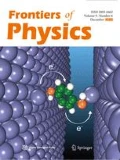Abstract
By solving the quantum Vlasov equation, electron-positron pair production in a strong electric field with asymmetric laser pulses has been investigated. We consider three different situations of subcycle, cycle and supercycle laser pulses. It is found that in asymmetric laser pulse field, i.e., when the pulse length of one rising or falling side is fixed while the pulse length of the other side is changed, the pair production rate and number density can be significantly modified comparable to symmetric situation. For each case of these three different cycle pulses, when one side pulse length is constant and the other side pulse length becomes shorter, i.e., the whole pulse is compressed, the more pairs can be produced than that in the vice versa case, i.e., the whole pulse is elongated. In compressed pulse case there exists an optimum pulse length ratio of asymmetric pulse lengths which makes the pair number density maximum. Moreover, the created maximum pair number density by subcycle pulse is larger than that by cycle or/and supercycle pulse. In elongated pulse case, however, only for supercycle laser pulse the created pairs is enhanced and there exists also an optimum asymmetric pulse length ratio that maximizes the pair number density. On the other hand, surprisingly, in both cases of subcycle and cycle elongated laser pulses, the pair number density is monotonically decreasing as the asymmetry of pulse increases.
Similar content being viewed by others
References and notes
F. Sauter, Über das Verhalten eines Elektrons im homogenen elektrischen Feld nach der relativistischen Theorie Diracs, Z. Phys., 1931, 69(11–12): 742
W. Heisenberg and H. Euler, Folgerungen aus der Diracschen Theorie des Positrons, Z. Phys., 1936, 98(11–12): 714
J. S. Schwinger, On Gauge invariance and vacuum polarization, Phys. Rev., 1951, 82(5): 664
V. Yanovsky, V. Chvykov, G. Kalinchenko, P. Rousseau, T. Planchon, T. Matsuoka, A. Maksimchuk, J. Nees, G. Cheriaux, G. Mourou, and K. Krushelnick, Ultra-high intensity-300-TW laser at 0.1 Hz repetition rate, Opt. Express, 2008, 16(3): 2109
G. Mourou, T. Tajima, and S. Dulanov, Optics in the relativistic regime, Rev. Mod. Phys., 2006, 78(2): 309
M. Dunne, A high-power laser fusion facility for Europe, Nat. Phys., 2006, 2(1): 25 http://hiper-laser.org/.
R. Alkofer, M. Hecht, C. Roberts, S. Schmidt, and D. Vinnik, Pair creation and an X-ray free electron laser, Phys. Rev. Lett., 2001, 87(19): 193902
C. D. Roberts, S. M. Schmidt, and D. V. Vinnik, Quantum effects with an X-ray free-electron laser, Phys. Rev. Lett., 2002, 89(15): 153901
A. Ringwald, Pair production from vacuum at the focus of an X-ray free electron laser, Phys. Lett. B, 2001, 510(1–4): 107
D. B. Blaschke, A. Prozorkevich, C. Roberts, S. Schmidt, and S. Smolyansky, Pair production and optical lasers, Phys. Rev. Lett., 2006, 96(14): 140402
V. S. Popov, Pair production in a variable external field (Quasiclassical approximation), Sov. Phys. JETP, 1972, 34: 709
S. S. Bulanov, Pair production by a circularly polarized electromagnetic wave in a plasma, Phys. Rev. E, 2004, 69(3): 036408
B. S. Xie, M. Melike, and D. Sayipjamal, Electron-positron pair production in an elliptic polarized time varying field, Chin. Phys. Lett., 2012, 29(2): 021102
G. Dunne and C. Schubert, Worldline instantons and pair production in inhomogenous fields, Phys. Rev. D, 2005, 72(10): 105004
F. Hebenstreit, R. Alkofer, and H. Gies, Schwinger pair production in space- and time-dependent electric fields: Relating the Wigner formalism to quantum kinetic theory, Phys. Rev. D, 2010, 82(10): 105026
M. Orthaber, F. Hebenstreit, and R. Alkofer, Momentum spectra for dynamically assisted Schwinger pair production, Phys. Lett. B, 2011, 698(1): 80
J. C. R. Bloch, V. Mizerny, A. Prozorkevich, C. Roberts, S. Schmidt, S. Smolyansky, and D. Vinnik, Pair creation: Back reactions and damping, Phys. Rev. D, 1999, 60(11): 116011
J. C. R. Bloch, C. Roberts, and S. Schmidt, Memory effects and thermodynamics in strong field plasmas, Phys. Rev. D, 2000, 61(11): 117502
D. V. Vinnik, A. V. Prozorkevich, S. A. Smolyansky, V. D. Toneev, M. B. Hecht, C. D. Roberts, and S. M. Schmidt, Plasma production and thermalisation in a strong field, Eur. Phys. J. C, 2001, 22(2): 341
A. Nuriman, B. S. Xie, Z. L. Li, and S. Dulat, Enhanced electron-positron pair creation by dynamically assisted combinational fields, Phys. Lett. B, 2012, 717(4–5): 465
B. F. Shen and J. Meyer-ter-Vehn, Pair and γ-photon production from a thin foil confined by two laser pulses, Phys. Rev. E, 2001, 65(1): 016405
C. P. Ridgers, C. S. Brady, R. Duclous, J. G. Kirk, K. Bennett, T. D. Arber, A. P. L. Robinson, and A. R. Bell, Dense electron-positron plasmas and ultraintense γ rays from laser-irradiated solids, Phys. Rev. Lett., 2012, 108(16): 165006
Author information
Authors and Affiliations
Corresponding author
Rights and permissions
About this article
Cite this article
Oluk, O., Xie, BS., Bake, M.A. et al. Electron-positron pair production in a strong asymmetric laser electric field. Front. Phys. 9, 157–163 (2014). https://doi.org/10.1007/s11467-013-0379-8
Received:
Accepted:
Published:
Issue Date:
DOI: https://doi.org/10.1007/s11467-013-0379-8




